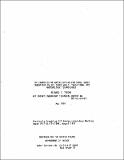The economics of water lifting for small scale irrigation in the third world: traditional and photovoltaic technologies
Author(s)
Tabors, Richard D.
DownloadMIT-EL-79-011-06517174.pdf (1.064Mb)
Metadata
Show full item recordAbstract
Much of the non-traditional, irrigated, agricultural land in
developing nations utilizes pumping technologies which have been adapted
from the developed nations. These technologies are adaptable to the
medium and large scale farms (individual farms in excess of 2 hectares)
but are not adaptable to smaller farms. It has been these larger third
world farmers who have been able to take the fullest advantage of the
benefits of new seed varieties in wheat and rice combined with fertilizer
and water, the ingredients of the "green revolution." This short paper
summarizes the experience to date of developing water pumping systems for
small farms in selected deltaic areas of the 'third world,' those areas
in which irrigation water is available at depths between 1.5 and 4.5
meters (m). These areas include the Nile, Euphrates, Indus, Ganges,
Irrawaddy, and Mekong River Basins which combined encompass 50 million
hectares of the earth's surface (less than one percent of the earth's
land area) and contain roughly 250 million people (nearly 7 percent of
the world's population).
The analyses evaluate water supplied by traditional means--human and
animal--by conventional systems--diesel, gasoline and electric--and by
renewable resource systems, in particular photovoltaic powered systems.
A review of previous studies indicate that the value of water for
irrigation is in the range of two to three cents (U.S.) per cubic meter
(m3). The methods of lifting water, available to farmers on land areas
of one hectare or less, provide water at costs in excess of this two to
three cents (U.S.) per m3. Investigations of the Shadoof systems of
North Africa and Asia show costs of water as high as seven cents (U.S.)
per cubic meter. An evaluation of animal power used to operate a Persian
wheel resulted with water costs that varied with the amount of feed
required by the animal from 1 to 4/m3.
Four pumping systems were investigated using conventional power
systems: two diesel, one gasoline, and one electric. Since pumping
systems have relatively fixed sizes and prices, the costs generally
exceed the benefits for the small farmer. The cost per cubic meter for
irrigating one hectare averaged: 3.5¢ (U.S.) for diesel in Chad; 4.0¢
(U.S.) for gasoline in Chad; 3.5Q (U.S.) for diesel in India; and 3.0t
(U.S.) for electricity in India. In each of these instances, the cost of
supplying small scale farmers with water using conventional systems was
greater than the economic value of the water supplied. A fifth pumping
system investigated herein utilized a high technology power system,
photovoltaic cells combined with efficient electric motor and pump
devices. The cost of providing water utilizing the photovoltaic power
system resulted in costs of 2.8t/m3 (U.S.) to lift the water 1.5m and
5.44/m3 (U.S.) for lifting heads of 4.5m, at today's cell prices
($10/Wp). If photovoltaic power system costs are reduced to $4.00 per
peak watt (Wp), the cost of irrigation water for a lift of 1.5m would be
1.2¢/m3, and for a lift of 4.5m would be 2.3*/m3.
Description
Previously issued as MIT Energy Laboratory Working paper # MIT-EL-78-015wp, August 1978.
Date issued
1979-05Publisher
MIT Energy Laboratory
Other identifiers
06517174
Series/Report no.
MIT-EL79-011
Keywords
Developing countries |x Irrigation.
Collections
The following license files are associated with this item: